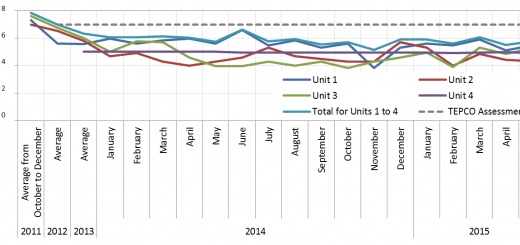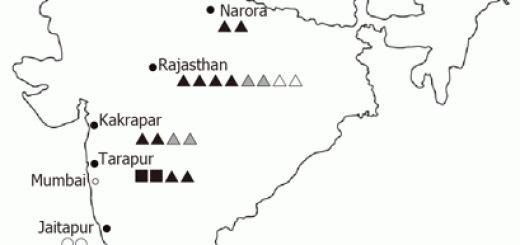Nuclear State and Industry: Bottomless Depths of Corruption Nuke Info Tokyo 118
As reported in NIT 117, a web of falsification and deception in Japan’s electric power industry was uncovered late in 2006. On 30 March 2007, all 12 power companies submitted reports to the government. Their reports, covering nuclear, fossil fuel and hydroelectric power stations, identified a colossal 10,646 irregularities. Of those, 455 cases involved nuclear power plants, including 230 at Tokyo Electric Power Company (TEPCO) and 123 at Chubu Electric1.
On April 6th, power companies submitted reports to the Nuclear Industrial and Safety Agency (NISA) explaining how they propose to prevent such problems arising in future. NISA responded on April 20th by announcing administrative proceedings against four companies2 in relation to seven reactors. The penalty imposed is that the companies must alter their safety provisions. NISA has not demanded that reactors be shut down, nor has it suspended any licenses. With such lenient treatment as this, one can hardly expect that such problems will not arise in future.
A previous TEPCO scandal came to light in August 2002 when a whistleblower revealed that the company had falsified inspection records and concealed problems at its nuclear power plants. Thereafter, similar problems were discovered at plants belonging to other power companies. On that occasion TEPCO was forced to close down all 17 of its nuclear reactors. Four directors accepted responsibility by resigning and the company promised to work to recover public trust. This time there is little evidence of contrition.
During the 2002 scandal, the discovery of corruption in the government’s periodic inspections showed the hollowness of Japan’s nuclear safety system. This time the Minister for Economy Trade and Industry directed that a thorough investigation be carried out to “uncover the truth with no concealment”. However, by rights, these problems should have been identified at the time of the 2002 scandal. The root of the problem is that the government, the power companies and the plant makers are all in bed together. What we are seeing once again is the true nature of Japan’s nuclear club.
Prompt Criticality Incident at Shika-1
As reported in NIT 117, Hokuriku Electric failed to report a criticality incident in June 1999. The incident arose when three control rods dropped out of position during a periodic inspection at the Shika-1 reactor (BWR, 540 MW). The Japan Nuclear Technology Institute concluded that it was possible that the core was in “prompt criticality”, meaning that the reaction was sustained by prompt (immediately released) neutrons alone. The incident has been provisionally categorized as a Level 2 incident on the International Nuclear Event Scale (INES).
There are two typical kinds of nuclear accident which can develop into major accidents. These are loss of coolant accidents and reactivity accidents. Three Mile Island (1979) was an example of the former, while Chernobyl (1986) was an example of the latter. A rapid increase of reactivity at the Chernobyl-4 reactor gave rise to an uncontrolled chain reaction. The incident at Shika-1 was a reactivity accident. It demonstrated that nuclear reactors are dangerous even when they are closed for periodic inspections.
Earthquake near Shika NPP
On March 25th this year a magnitude 6.9 earthquake struck the Noto Peninsula on which the Shika nuclear power plant (NPP) is located. The second floor basement of the Shika-1 and Shika-2 reactors registered shakes of 239 gal and 264 gal respectively. These reactors are set so that they scram if there is a quake of 190 gal and 185 gal respectively. As it happens, Shika-1 was down because of the discovery of the criticality incident, while Shika-2 was closed because of problems with its turbines (see NIT 113 & 115). The government’s earthquake Headquarters for Earthquake Research Promotion announced that it is likely that a fault that was not considered in Hokuriku Electric’s earthquake safety assessments for the Shika reactors moved together with another fault. This is further proof of the inadequacy of earthquake safety measures at nuclear facilities in Japan.
Revelations continue
On April 6th Hitachi submitted a document revealing an additional incident involving TEPCO. In October 1988, one of the 185 control rod drive mechanisms in the Fukushima II-4 reactor was out of order. TEPCO requested Hitachi to inscribe the serial number of the out of order control rod drive mechanism onto a new one and load it without subjecting it to the required government inspection. Two of the four people involved in this incident are still working at TEPCO. The power company and manufacturer were fully aware that their action was illegal when they conspired to deceive the government, but the government’s nuclear safety inspectorate was incapable of uncovering the deception.
During the 2002 TEPCO scandal, a suspension order was imposed on TEPCO’s Fukushima I-1 reactor in 2002. The order related to falsification of an airtightness test on the reactor containment vessel during a periodic inspection in 1992. (As with the Fukushima II-4 case, Hitachi and TEPCO were both involved.) When the incident came to light, the government imposed a one-year suspension order on the grounds that it was a case of malicious falsification relating to equipment that was important for reactor safety and as such it was even more serious than the systematic falsification of inspection records for voluntary inspections. Why then, one must ask, was not a suspension order imposed for the incident at Fukushima II-4?
Can we be sure that there are no more incidents to be uncovered? Certainly not. NISA admitted as much during a meeting with politicians and citizens groups on April 13th. It seems that the depths of corruption in Japan’s nuclear industry are unfathomable.
Can nuclear power be made safe?
Many people saw the 2002 TEPCO scandal as a red light for Japan’s nuclear power plan. The general view at the time was that neither the power companies, nor the plant makers, nor the government could be trusted. However, some people hoped that this would be a wake up call. They hoped that in future plants would be operated with more caution and that there would be more disclosure of information.
In September 2002, after reflecting on its misdeeds, TEPCO announced a plan of preventative action. It promised to adopt various measures, including increasing transparency, improving company culture and instilling corporate ethics. Following the latest revelations, on 6 April 2007 TEPCO submitted a 12-point action plan to the government. Other companies also submitted plans, which included such things as prioritizing regulatory compliance. But do these plans address the real problem?
The first thing to realize is that companies exist to make profits. They will only behave ethically if it does not impede this prime objective. They will not prioritize nuclear safety if it threatens their continuing corporate existence. Secondly, the regulatory framework is never perfect. At best, it establishes the minimum necessary conditions. The question then arises of who judges whether the regulations are being followed. It has become clear that we cannot trust the regulator any more than the companies, but even if it wanted to, NISA does not have the ability to properly check what is going on. When representatives of CNIC and other NGOs visited NISA on April 13th, NISA showed not the slightest sign of remorse. The fact that it is located within the Ministry of Economy Trade and Industry, which also has the role of promoting nuclear power, does not help of course.
Despite all the talk of fixing the problems within the nuclear industry, little improvement is seen. As the saying goes, it is hard for a leopard to change its spots. Maintaining complete control over the process of nuclear fission is extraordinarily difficult at the best of times. It is difficult enough when there are no cover-ups or data falsifications. Furthermore, this is an industry where complete freedom of information is impossible for security reasons. Even in the hands of scrupulously honest people, highly skilled and alert to all the dangers, it is doubtful whether human beings are capable of safely operating nuclear power plants. As it is, these ideal conditions will never prevail. We must therefore conclude that the dangers posed by nuclear energy are just too great.
Yukio Yamaguchi (CNIC Co-Director)
1. If each incident is counted separately the number is much larger.
2. Japan Atomic Power Company, Hokuriku Electric, Chugoku Electric and TEPCO.
3. When control rods are removed from boiling water reactors (BWR) they are positioned below the reactor, whereas they are positioned above the reactor in pressurized water reactors (PWR). It is possible for control rods to fall out of BWR reactors under the force of gravity. However, it is also possible for control rods to be expelled upwards from PWRs during start-up.


